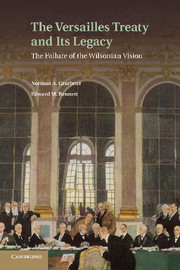Book contents
- Frontmatter
- Contents
- Preface
- 1 The International Order on Trial
- 2 The Road to Paris: 1917???1918
- 3 Versailles: A Study in Arrogance
- 4 The Retreat to Utopia
- 5 Manchuria and the Triumph of Non-Recognition
- 6 The Rise of Hitler
- 7 Challenge of the Dictators
- 8 The Elusive Response
- 9 Munich: The Continuing Escape from Reality
- 10 The Road to Prague
- 11 The Soviet Quest for Collective Security
- 12 The Coming of War: 1939
- Bibliography
- Index
- References
5 - Manchuria and the Triumph of Non-Recognition
Published online by Cambridge University Press: 07 October 2011
- Frontmatter
- Contents
- Preface
- 1 The International Order on Trial
- 2 The Road to Paris: 1917???1918
- 3 Versailles: A Study in Arrogance
- 4 The Retreat to Utopia
- 5 Manchuria and the Triumph of Non-Recognition
- 6 The Rise of Hitler
- 7 Challenge of the Dictators
- 8 The Elusive Response
- 9 Munich: The Continuing Escape from Reality
- 10 The Road to Prague
- 11 The Soviet Quest for Collective Security
- 12 The Coming of War: 1939
- Bibliography
- Index
- References
Summary
I
As an Allied power, Japan emerged triumphant from the Paris Peace Conference. It had acquired Shantung as well as Germany’s Pacific islands north of the equator. Yet ultimately Japan found the post-war settlement no more satisfactory than did Germany or Russia. Not only were Japan’s wartime designs on China, as embodied in the Fifteen Demands of 1915, generally unfulfilled, but also, as the self-appointed leader of Asian independence, Japan had failed to replace the Western imperial structures in the Orient with a body of independent Asian states in a Japanese-led East Asian hegemony. Post-war Japan possessed two powerful weapons: its own expansive energy, backed by an efficient economy and an impressive navy, as well as the force of anti-colonialism, aggravated by the failure of self-determination at Paris. For Asian leaders generally, the Versailles settlement was intolerable. Confronted by the dual forces of Japanese expansionism and Asian nationalism, the Western powers could anticipate pressures for change in the Orient that presaged the retreat of Western power and influence. Predictably, Japan would lead the assault.
Japan, burdened with an excess of population and a shortage of resources, could expand nowhere on the Asian mainland or across the Pacific without inviting condemnation, if not retaliation, from the Western imperial nations. Japanese ambitions had long made clear that Britain, France, The Netherlands, and the United States – the primary guardians of the Far Eastern status quo – would either accept a more equitable distribution of territory, authority, and resources in Asia, or they would maintain their hegemony at increasingly high cost.
- Type
- Chapter
- Information
- The Versailles Treaty and its LegacyThe Failure of the Wilsonian Vision, pp. 89 - 106Publisher: Cambridge University PressPrint publication year: 2011



